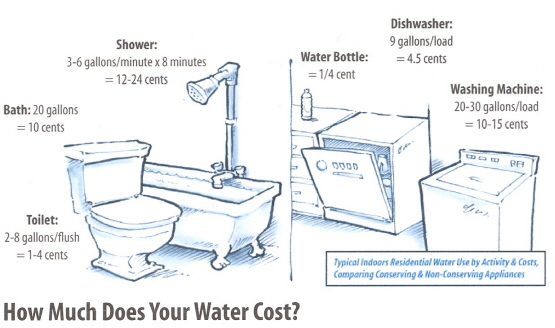
1. How can I evaluate and reduce my Ann Arbor water bill?
1A. Have you looked online to see your water usage history to identify where and when your water usage may be higher?
- Yes, I want to interpret my online water consumption results and get some general guidelines on how to save water.
- No, I need help to see my online water consumption rate. Here’s how to log into your own water consumption data. Before you begin, write down your water account number as listed on your water bill. Then, log into the city’s Web site at www.a2gov.org and select “My Property Information” from the “Living In’ heading. Enter your address. Select the water tab option and key in your water account number. You are now able to see your water bill account and track your daily, monthly, and annual water usage in several formats. To look for reasons and suggested remedies for typical higher water use, please go to 1B.
- Help! If you don’t have access to a computer at home or need more assistance, please call the Customer Service Center at 734.794.6333 during weekday business hours to review your water usage report together with an account representative.
1B. I notice increases in my online water usage tracking.
As a baseline number, a typical residence uses 10 units of water (or 7480 gallons) per person every three months for each quarterly billing cycle, or about 83 gallons of water, per person per day. This number is an average; your water use may be higher or lower than this, depending on your usage pattern. Residential water consumption typically shows higher water usage in the warm months and lower water usage in the colder months, when we are not watering lawns or running air conditioners.
Are you seeing a sudden or continuous spike in water use? A faucet leak of just one drop a second wastes 2,400 gallons in a year! Check and fix any pipe, faucet, or appliance that has leaks or drips. Not sure where to start? Look at your water meter to see if the flow indicator meter is moving even if all the water taps are turned off. If the meter is steadily moving, this indicates water is running somewhere and is possibly a leak. Look for faucet drips and listen for running water sounds from the refrigerator ice-maker, toilets, hot water heater, humidifiers, outside faucets and sprinklers.
According to the New Resources Group, a 'running' toilet can waste up to 200 gallons of water a day! Here’s how to check toilets for leaks. Remove the lid of the water tank, located behind the toilet, and add six-ten drops of vegetable dye (sold in the baking aisle) or use a vegetable dye tablet (such as colored egg dyes) to the water tank reservoir. Wait 15 minutes to see if any dye leaks into the toilet bowl, indicating a leak. You then need to fix the toilet leak. How-to steps for fixing leaks and other water conservation tips are provided in a Do-it-Yourself Home Water Audit Kit, for $2 each, while supplies last, available from the Customer Service Center on the first floor of City Hall, 301 E. Huron, during weekday business hours, 734.794.6333.
If you notice seasonal water use during specific periods, reflect what activities you may have arise during these months. Higher water use typically arises with filling pools, washing cars, and operating water-cooled air conditioners or humidifiers. House guests, holiday visitors, and other types of special events may boost your water usage periodically.
Do you notice more water usage in the warm weather? Outdoor irrigation, watering lawns and gardens, can double your water usage. Reducing outdoor irrigation doesn’t need to mean a dead landscape! Look for several outdoor water-saving tips and other conservation suggestions in Question #6.
Return to the Consumer's Guide to Tap Water main page
